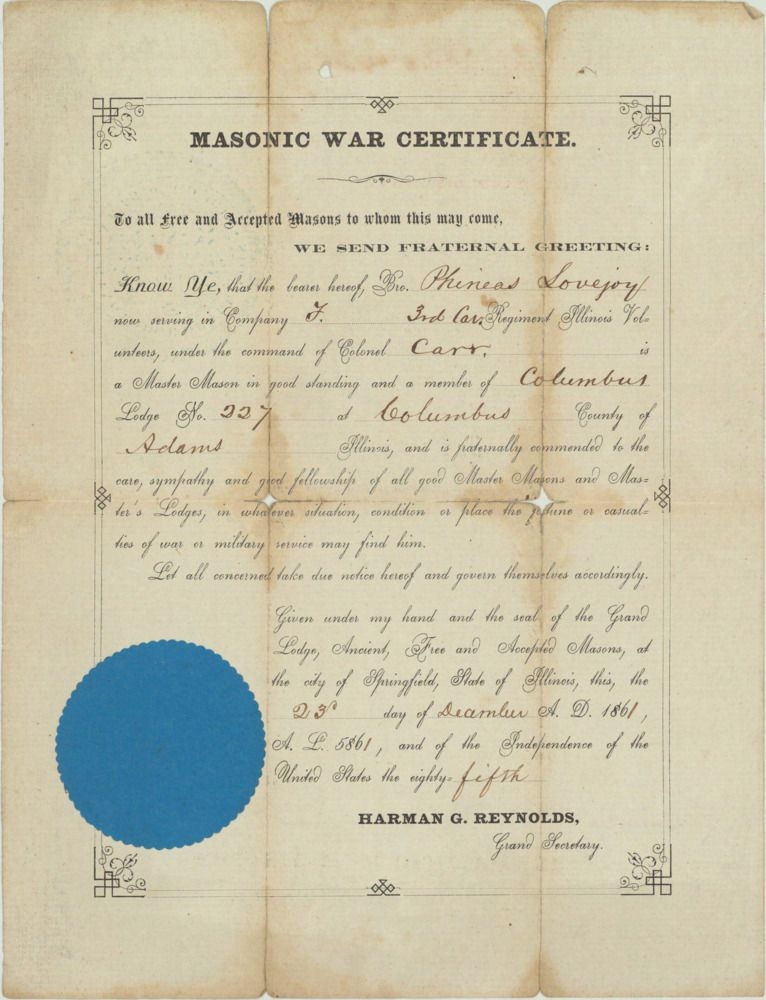A House Divided: Illinois Freemasonry During the American Civil War


The Masonic War Certificate
As Illinois regiments mustered and prepared to march south, the Grand Lodge of Illinois undertook a unique and compassionate initiative. Between April 1861 and September 1863, it issued 1,757 documents known as "Masonic war certificates". These were not military papers, but fraternal ones.
The purpose of these certificates was extraordinary: they were designed as a type of traveling document that an Illinois soldier, if captured or wounded, could present to a Confederate soldier who was also a Mason. The certificate would vouch for the holder's good standing in the fraternity, serving as a plea for Masonic aid and relief that was intended to transcend the political and military allegiances of the war. One such certificate was issued on December 23, 1861, to Corporal Phineas Lovejoy of the 3rd Regiment, Illinois Cavalry, a farmer and town clerk who had swiftly joined the army after the firing on Fort Sumter.
The very existence of these certificates is a powerful statement. It demonstrates that the leadership of the Grand Lodge of Illinois believed that the Masonic obligation to relieve a brother's suffering was a sacred duty that did not end at the battle line. It was a tangible tool provided to its members to encourage acts of mercy and compassion, even toward an enemy combatant, based solely on their shared identity as Freemasons. This was an attempt to maintain a fundamental bond of humanity in a conflict defined by dehumanization.

Post-War Growth and Reconciliation
While the war inevitably took its toll, Freemasonry in Illinois did not just survive; it thrived in the aftermath. The post-Civil War era saw a massive boom in fraternalism across America, and Illinois was no exception. The number of lodges grew rapidly, and by 1888, the Grand Lodge of Illinois was the second-largest in the United States, surpassed only by New York.
This post-war flourishing suggests that the fraternity's role during the conflict may have enhanced its appeal. In a nation deeply wounded and in desperate need of reconciliation, Freemasonry offered a space where men, including former Union and Confederate soldiers, could once again meet as brothers. It was an institution that had proven its commitment to a brotherhood that could withstand even the nation's most profound division, making it a vital force for healing and unity in the decades that followed.
The story of Illinois Freemasonry during the Civil War is a poignant testament to the fraternity's highest ideals. At a time of ultimate national schism, it actively worked to maintain the bonds of fellowship, offering a glimmer of unity in a fractured republic and reminding its members that the duties of a Mason extend to all of humanity.
.jpg&w=3840&q=100)
Discover the life of Shadrach Bond, the pioneer who served as Illinois' first Governor and laid the foundation for the state's Freemasonry

From Chicago's oldest lodge to magnificent temples across the state, take a tour of the architectural landmarks that tell of Illinois Freemasonry

Freemasonry's core tenets are Brotherly Love, Relief, and Truth. See how Illinois Masons act on these through their extensive charitable programs.

From a single lodge in the frontier town of Kaskaskia in 1805, discover the rugged origins of Illinois Freemasonry and its role in shaping the state.
Comments
No comments yet. Be the first to comment!